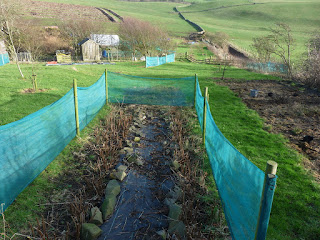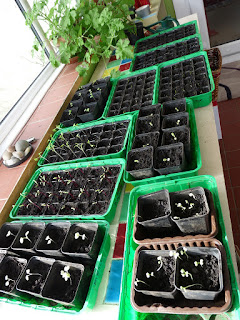 |
| That's the autumn raspberries pruned |
 |
| Frost flowers on the polytunnel |
 |
| OMG celeriac crisps |
 |
| Our wildlife pond |
 |
| Cloches for early sowing |
February has been the coldest month so far, with several frosty nights. We even had some frost flowers on the polytunnel - a first! Still, the cold hasn't held back the rhubarb or the daffodils.
We've used the cold and windy days to do a lot of food processing: another seven litres of kimchi are fermenting and several litres of ice cream made from local milk (vanilla, eggnog, chocolate and rum & raisin flavours) are chilling in the new freezer. It's nice to be able to all this processing at this time of year rather than in the summer and early autumn.
Another culinary highlight of the month has been our discovery of celeriac crisps. At least as delicious as potato crisps! Luckily we still have a dozen whole celeriacs left. Even more will be planted this year.
The pond area has had a full work over, with quite a few irises removed, and the frogs and toads obligingly deposited loads of spawn on 17 February. We also managed to clear the remaining bramble wilderness behind the pond and plant a rosa rugosa hedge with suckers from our existing plants. This means perimeter hedging is now complete.
But there was even more hedging to be done. A change in SEPA farmland regulations means that watercourses have to be fenced off from livestock so our neighbouring farmer fenced off the burn on the southern perimeter of our land. He gave us permission to plant in this strip - so in went 100 or so willow cuttings and some more rosa rugosa suckers. This is great news for us: Not only won't the cattle nibble on our hedge any more, we can also create double or triple hedging to the windiest side and create a nice wildlife habitat at the same time.
 |
| The new growing area, for this year's potatoes |
After the hedge planting it was time to turn to digging. We moved the first bit of black plastic in the bottom paddock to start on this year's potato area. The soil looks good underneath, if a little heavy and several voles, who had a cosy environment beneath the plastic, scurried away. This time we are going to remove the plastic bit by bit so that weeds don't start to sprout again before Jim can get to the digging. I've started aerating the soil with the broadfork to help it dry a bit before digging commences. In the meantime the potatoes are chitting. The earliest we can plant them is last week in March, weather permitting.
 |
| Splitting wood - a regular workout |
Wood processing continues when the weather is favourable. We're thinking about the best way to construct more permanent log stores. The split wood that we've stacked outside in between stacks of tree disks and roofed over with polycarb sheeting (weighed down by fish boxes full of stones) has dried much better than that in the wood shed. So we'll likely make permanent shelters next to the garage first, before tackling the shed.
 |
| Conservatory filling up with seedlings |
When it comes to seed sowing, it's a real patience game this month. We don't want to sow things too early. Tomatoes, chillies and peppers, for example, will have to wait until the first week in March. Otherwise they just get too spindly before it's warm enough to plant them out into the polytunnel and greenhouse. However, there has been some early sowing of seeds: leeks (three varieties, colour-coded - the earliest variety is yellow), pak choi, lettuce, tatsoi, spring cabbage, beetroot and cauliflower. And since the weather has been mild, we also sowed some crops under cloches and in the polytunnel: shallots, hardy carrots, rocket, red mustard, radish, kohlrabi and more beetroot. Not long to wait now until the tomatoes get sown!
No comments:
Post a Comment
Comments and questions are welcome.
If you've tried something after reading about it here, or have suggestions, please tell us about it!